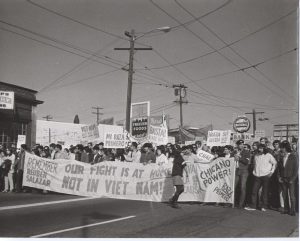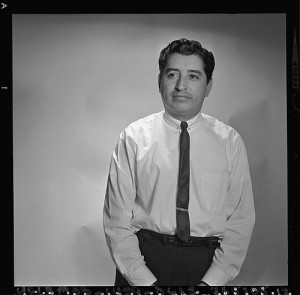The Significance of the Chicano Moratorium
-Eldridge Cleaver
Many will ask what is the purpose of commemorating the Chicano Moratorium each year in August. The original National Chicano Moratorium march and protest against the Vietnam War was held in East Los Angeles on August 29, 1970. Two previous smaller marches took place in L.A. in order to organize for the larger August 29, 1970, national march. Other build-up marches were also organized in San Francisco, Oakland, Fresno and other cities.

The culminating march and protest that was held on August 29, drew over 25,000 participants from various parts of the country.
This significant event was an historical and political watershed for Chicanos as their emerging role and voice in this society had finally asserted themselves in a bold and proud manner which overturned the conservative politics of a previous generation. The importance of the Chicano Moratorium is that it has now become a part of our tradition and culture and should be commemorated as such each year with a sense of pride and recommitment. This pride and legacy requires a renewed dedication to continue the political, social and cultural activism that is aimed at promoting progress within our communities.
To just sit around and simply be proud cannot replace such an activism as new problems and issues that affect us need to be engaged and resolved with concrete solutions. Attempting to retreat and escape into our own little world and pretend that these problems will go away is no solution and makes the situation become even worse. If these problems impact one of us, they will eventually impact all of us as they require a united and active response.
What level of progress have we achieved since 1970?
The Vietnam War was ended due to domestic pressure that was applied on the government in the form of massive protests throughout the country in which Chicanos played a key role. There has been some quantitative progress made in the level of civil rights achieved since 1970, but it has fallen far short of full social and political equality. Today, many of these hard-won rights are being slashed by the regressives and outright racists. This situation is especially true for the majority in the barrios whose progress has stagnated. The recent unrest and clashes in Anaheim California and other areas that have resulted from a deeply ingrained social and political inequality are an example of this continuing second-class status. The blatant discrimination and promotion of stereotypes that still exist within the Anaheim schools is reminiscent of the 19502s or worse and needs to be totally eliminated.
Many of the activists who participated in the 1970 Moratorium have since moved on to new and better lives while some are still active despite the ups and downs of the political movement. Most political movements do not continue at a consistently high level as they have an ebb and flow nature to them that is determined by objective conditions.
However, what is needed is a consistent and unified response to actively confront any new violations of our basic rights. Many old problems have been resolved since the original Moratorium, some issues still persist, while new ones have arisen. To state that nothing has changed is an incorrect and static way of thinking as change is constant. We must be able to adapt accordingly with our tactical activities to confront the new conditions and issues that we face. Looking back, one particular and serious shortcoming that emerged out of the post 19702s was an insufficient amount of training that was given to the next generation of young activists in order to ensure the political consistency and leadership of these struggles.
The significance of the Chicano Moratorium: nostalgia or political activism?
The cultural importance of the Chicano Moratorium lies in its tradition of being involved in the social, political and cultural work that improves our communities and the continuation of the struggle for basic civil rights and equality. The location of the 1970 National Chicano Moratorium in East Los Angeles does not make it only a local tradition as the site was not the important element. This historical event and rich cultural legacy belong to all Chicanos and Latinos who embrace its proud symbolism and lessons of struggle that further the demand and quest for social justice.
The tradition and legacy of the Chicano Moratorium is something that is alive and active when applied to today’s conditions and should not be viewed as some sort of interesting historical relic to be intellectualized over at a reunion.
Neither should the Moratorium be commemorated as a bit of lifeless nostalgia and a walk down memory lane interspersed with cults of personality and then left at that. A people’s culture and traditions are created by their struggles and experiences and the Chicano Moratorium was one of the pinnacles of this historical social practice and as such enriched our cultural legacy. This rich tradition can only be further strengthened by continuing our present struggles. In 2012, our task is to commemorate the legacy of the Moratorium by making a commitment to expand and deepen its lessons by confronting the social problems presently facing us, and by doing so, we will collectively enhance our cultural experience and tradition even further.
Presently, there is still much to be done
One thing is certain during this present period which is that we cannot live narrowly within our own shell and avoid what is occurring throughout society. New problems arise in the form of new issues that must be dealt with and resolved in our personal lives as well as within our communities. Chicanos are not a monolithic group as they are members of different social classes.
The middle class that has developed since the 19702s is facing a wall of obstacles that deny it further financial and social opportunities as the country’s economic pie shrinks. Leaving the barrios has not solved all of the problems for these new middle class Chicanos as the increasing financial pressure to provide an adequate education, housing and health care for their families has stifled their social mobility and pushed many of them downward.
Working class Chicanos and other Latinos in the barrios face numerous economic problems such as funding cuts to vital social services, lay-offs and a loss of homes. Social issues such as deteriorating schools and health care have been accompanied by the growth of gangs and drug use within their neighborhoods. Laboring under inhumane conditions that are reminiscent of the Middle Ages, millions of farm workers still work the land that is owned by the few who grow richer as the misery of the farm workers increases. These agricultural workers still endure low pay, unsafe working conditions, sub-standard health care, their children laboring in the fields instead of attending school, and the lack of union organization and laws to protect their interests.
Chicano youth also face an uphill struggle in society as college costs have spiraled drastically while the future prospects for a secure and decent job have dwindled. Other related problems such as gang membership, drug use, the pressure to join the military with its possibility of death, have created obstacles to a stable future for young people. The Chicano intelligentsia within the universities is experiencing a growing campaign of funding cuts and efforts to diminish or eliminate Chicano Studies programs which if successful will negatively affect their students and the jobs of these professors. The situation of many Latino immigrants is precarious not only from an economic standpoint, but also a legal one as they have to live under the increasing threat of deportation while their children exist in a legal limbo where they are unsure of their future status or rights.
Commemorate the martyrs of the Moratorium by continuing their struggle

The march and protest against the Vietnam War and for justice here at home that took place on on August 29, 1970, was a peaceful one until it was attacked by the police authorities. This violent assault led to the deaths of three individuals: journalist Ruben Salazar, Brown Beret Lynn Ward and Angel Diaz. An Austrian student and political supporter named Gustav Montag was killed in 1971 by L.A. sheriffs at a subsequent Moratorium march that had also been attacked.
The commemoration of the cultural legacy and tradition of the Chicano Moratorium must also include a remembrance to the memories of these four martyrs who died in the resistance against injustice. They were heroes of the Moratorium who did not die in vain as their historical legacy lives on with that of this event. This Saturday, let us all commemorate this traditional event that is now an essential part of our history and culture, and the four martyrs who are symbols of our struggle by continuing their valiant work to achieve equal rights and justice.






